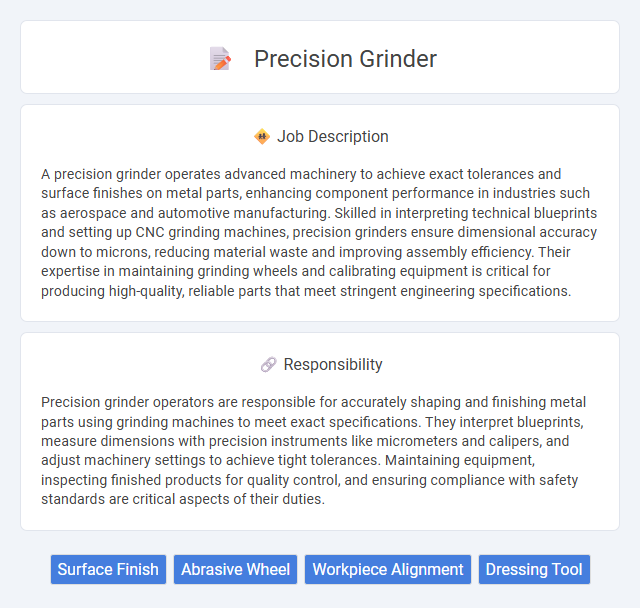
A precision grinder operates advanced machinery to achieve exact tolerances and surface finishes on metal parts, enhancing component performance in industries such as aerospace and automotive manufacturing. Skilled in interpreting technical blueprints and setting up CNC grinding machines, precision grinders ensure dimensional accuracy down to microns, reducing material waste and improving assembly efficiency. Their expertise in maintaining grinding wheels and calibrating equipment is critical for producing high-quality, reliable parts that meet stringent engineering specifications.
Individuals with strong attention to detail and excellent hand-eye coordination are likely suitable for a precision grinder job, as it requires careful control and accuracy. People who cope well with repetitive tasks and maintain focus in potentially noisy environments probably fit well within this role. Those with physical stamina and good spatial awareness may have higher chances of success in this occupation.
Qualification
Precision grinder positions require candidates to possess a high level of skill in operating grinding machines, interpreting blueprints, and performing quality inspections to ensure tight tolerances. Candidates typically need vocational training or an apprenticeship in machining or metalworking, along with experience in precision measuring tools such as micrometers and calipers. Certification from recognized industry bodies like the National Institute for Metalworking Skills (NIMS) enhances job prospects and validates expertise in precision grinding techniques.
Responsibility
Precision grinder operators are responsible for accurately shaping and finishing metal parts using grinding machines to meet exact specifications. They interpret blueprints, measure dimensions with precision instruments like micrometers and calipers, and adjust machinery settings to achieve tight tolerances. Maintaining equipment, inspecting finished products for quality control, and ensuring compliance with safety standards are critical aspects of their duties.
Benefit
A precision grinder job likely offers enhanced accuracy in shaping and finishing materials, resulting in improved product quality and consistency. This increased precision may reduce material waste and lower production costs, making manufacturing processes more efficient. Workers in this role probably benefit from developing specialized skills that are highly valued in industries requiring exact tolerances.
Challenge
Precision grinder jobs likely involve challenges related to maintaining exact tolerances and surface finishes on complex parts. The probability of encountering difficulties increases when working with hard materials or intricate geometries that require constant skill and concentration. Operators may need to adapt quickly to machine adjustments and unexpected variations in the workpiece to ensure consistent quality.
Career Advancement
Precision grinder careers demand skill in operating specialized machinery to achieve exact measurements and finishes on metal components, crucial for manufacturing high-quality parts in aerospace, automotive, and tool industries. Mastery of CNC grinding machines and proficiency in interpreting technical blueprints enhance job performance and open pathways to advanced roles such as CNC programmer or production supervisor. Continuous training in emerging technologies and certifications like OSHA safety standards significantly boost career advancement opportunities in this field.
Key Terms
Surface Finish
Precision grinder jobs require meticulous attention to achieve an optimal surface finish, often measured in microns to ensure minimal roughness. The surface finish directly impacts the functionality and longevity of mechanical parts, with typical Ra values ranging from 0.1 to 0.4 microns for high-precision applications. Advanced grinding machines utilize diamond or CBN (cubic boron nitride) wheels to consistently produce smooth, accurate surfaces essential for aerospace, medical, and automotive components.
Abrasive Wheel
Precision grinder jobs require meticulous control of the abrasive wheel to achieve exact dimensions and surface finishes on metal parts. The abrasive wheel's grit size, bonding material, and wheel speed directly influence cutting efficiency, heat generation, and surface integrity. Selecting the appropriate abrasive wheel type, such as aluminum oxide or silicon carbide, is critical for optimizing material removal rates and prolonging tool life in precision grinding applications.
Workpiece Alignment
Precision grinder job requires exact workpiece alignment to achieve high tolerance and surface finish accuracy. Proper alignment minimizes vibration, reduces tool wear, and prevents dimensional errors during grinding operations. Utilizing advanced fixtures and alignment tools ensures consistent positioning, leading to optimal grinding performance and part quality.
Dressing Tool
A precision grinder relies on a dressing tool to maintain the grinding wheel's shape, surface condition, and cutting efficiency. The dressing tool removes clogged debris, exposes fresh abrasive grains, and ensures consistent wheel sharpness, which directly impacts the surface finish and dimensional accuracy of machined parts. Regular dressing extends the grinding wheel life and optimizes precision in manufacturing processes such as aerospace, automotive, and tooling industries.
 kuljobs.com
kuljobs.com